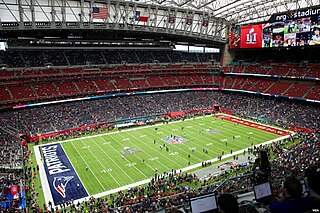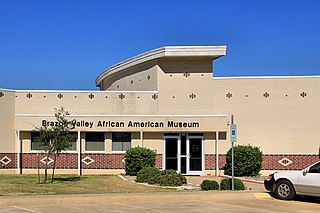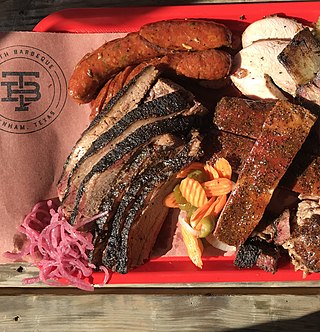
Texas is the most populous state in the South Central region of the United States. It borders Louisiana to the east, Arkansas to the northeast, Oklahoma to the north, New Mexico to the west, and the Mexican states of Chihuahua, Coahuila, Nuevo León, and Tamaulipas to the south and southwest. Texas has a coastline on the Gulf of Mexico to the southeast. Covering 268,596 square miles (695,660 km2), and with over 30 million residents as of 2023, it is the second-largest U.S. state by both area and population.

Rodeo is a competitive equestrian sport that arose out of the working practices of cattle herding in Spain and Mexico, expanding throughout the Americas and to other nations. It was originally based on the skills required of the working vaqueros and later, cowboys, in what today is the western United States, western Canada, and northern Mexico. Today, it is a sporting event that involves horses and other livestock, designed to test the skill and speed of the cowboys and cowgirls. American-style professional rodeos generally comprise the following events: tie-down roping, team roping, steer wrestling, Steer roping, saddle bronc riding, bareback bronc riding, bull riding and barrel racing. The events are divided into two basic categories: the rough stock events and the timed events. Depending on sanctioning organization and region, other events such as breakaway roping, goat tying, and pole bending may also be a part of some rodeos. The "world's first public cowboy contest" was held on July 4, 1883, in Pecos, Texas, between cattle driver Trav Windham and roper Morg Livingston.

Stamford is a city on the border of Jones and Haskell counties in west-central Texas, United States. The population was 3,124 at the 2010 census, down from 3,636 at the 2000 census. Henry McHarg, president of the Texas Central Railroad, named the site in 1900 for his hometown of Stamford, Connecticut. The city is home to the Texas Cowboy Reunion.

NRG Stadium is a multi-purpose stadium in Houston, Texas, United States. Construction was completed in 2002, at a cost of $352 million and has a seating capacity of 72,220. It was the first NFL facility to have a retractable roof.
The Houston Livestock Show and Rodeo, also called RodeoHouston or abbreviated HLSR, is the largest livestock exhibition and rodeo in the world. It includes one of the richest regular-season professional rodeo events. It has been held at NRG Stadium in Houston, Texas, since 2003, with the exception of 2021 due to the effects of the COVID-19 pandemic. It was previously held in the Astrodome. It is considered to be the city's "signature event", much like New Orleans's Mardi Gras, Dallas's Texas State Fair, San Diego's Comic-Con and New York City's New Year's Eve at Times Square.

East Texas is a broadly defined cultural, geographic, and ecological region in the eastern part of the U.S. state of Texas that comprises most of 41 counties. It is primarily divided into Northeast and Southeast Texas. Most of the region consists of the Piney Woods ecoregion. East Texas can sometimes be defined only as the Piney Woods. At the fringes, towards Central Texas, the forests expand outward toward sparser trees and eventually into open plains.

The following is an alphabetical list of articles related to the U.S. state of Texas.

The Cotton Bowl is an outdoor stadium in Dallas, Texas, United States. Opened in 1930 as Fair Park Stadium, it is on the site of the State Fair of Texas, known as Fair Park.
Dallas is a city in Texas, United States.
Houston is a multicultural city with a thriving international community supported by the third largest concentration of consular offices in the United States, representing 86 nations. In addition to historical Southeast Texas culture, Houston became the fourth-most populous city in the United States. Officially, Houston is nicknamed the "Space City" as it is home to NASA's Lyndon B. Johnson Space Center, where Mission Control Center is located. "Houston" was the first word spoken on the Moon. Many locals refer to Houston as "Bayou City." Other nicknames include "H-Town", "Clutch City", and "Magnolia City".
History of rodeo tracks the lineage of modern Western rodeo.

The culture of San Antonio reflects the history and culture of one of the state's oldest and largest cities straddling the regional and cultural divide between South and Central Texas. Historically, San Antonio culture comes from a blend of Central Texas and South Texas (Southwestern) culture. Founded as a Spanish outpost and the first civil settlement in Texas, San Antonio is heavily influenced by Mexican American culture due to Texas formerly being part of Mexico and, previously, the Spanish Empire. The city also has significant German, Anglo, and African American cultural influences. San Antonio offers a host of cultural institutions, events, restaurants and nightlife in South Texas for both residents and visitors alike.
Texas is home of several national sports league franchises among other professional sports, being the second most populated U.S. state. Since the state is located in the South Central United States, most teams are part of the Central / South or West league divisions, with the notable exception of the NFL Dallas Cowboys, which is an NFC East franchise.

The culture of Florida is often different in metropolitan areas than in more rural areas. Many parts of rural northern Florida is similar to the rest of American Southern culture, particularly around the Panhandle. In the larger cities such as Miami, Orlando, and Tampa, where there has been a large number of people moving from other parts of the United States, and even other areas of the world, the culture is much more diverse, and has been heavily influenced by Caribbean, Latin American, Jewish, and European culture. Thus, modern-day Florida, from the second half of the 20th century through today, has been heavily influenced by the cultures of people moving in from foreign countries and other parts of the United States, and is often a mix of cultures, values, and ideas.

African American Texans or Black Texans are residents of the state of Texas who are of African ancestry and people that have origins as African-American slaves. African Americans formed a unique ethnic identity in Texas while facing the problems of societal and institutional discrimination as well as colorism for many years. The first person of African heritage to arrive in Texas was Estevanico, who came to Texas in 1528.

Texan cuisine is the food associated with the Southern U.S. state of Texas, including its native Southwestern cuisine influenced Tex-Mex foods. Texas is a large state, and its cuisine has been influenced by a wide range of cultures, including Tejano/Mexican, Native American, Creole/Cajun, African-American, German, Czech, Southern and other European American groups. The cuisine of neighboring states also influences Texan cuisine, such as New Mexican cuisine and Louisiana Creole cuisine. This can be seen in the widespread usage of New Mexico chiles, Cayenne peppers, and Tabasco sauce in Texan cooking.
The Powell Brothers is a Country music recording artist from Kingwood, Texas. The group was formed by brothers Taylor and Blake Powell in February 2014.
The African American population in San Antonio, Texas has been a significant part of the city's community since its founding. African Americans have been a part of the Greater San Antonio's history since the late 1800s. San Antonio ranks as the top Texas destination city for Black professionals.
The COVID-19 pandemic in Texas is a part of the ongoing viral pandemic of coronavirus disease 2019 (COVID-19), a novel infectious disease caused by severe acute respiratory syndrome coronavirus 2 (SARS-CoV-2). The state of Texas confirmed its first case on February 13, 2020, among U.S. nationals evacuated from China to Joint Base San Antonio–Lackland beginning in early February; however, retrospective analyses have suggested a much earlier origin than previously thought. The first documented case of COVID-19 in Texas outside of evacuees at Lackland was confirmed on March 4 in Fort Bend County, and many of the state's largest cities recorded their first cases throughout March. The state recorded its first death associated with the disease on March 17 in Matagorda County.













